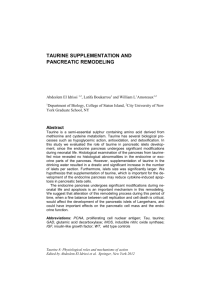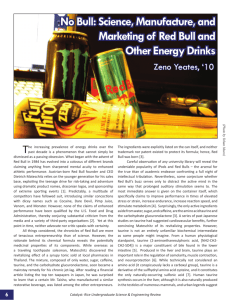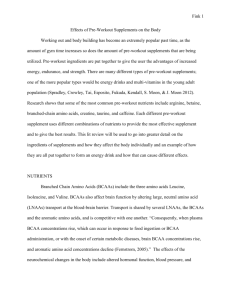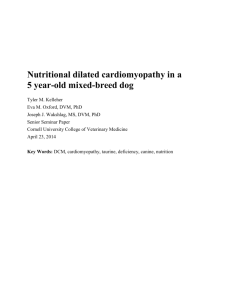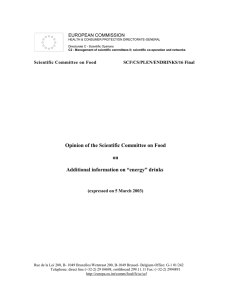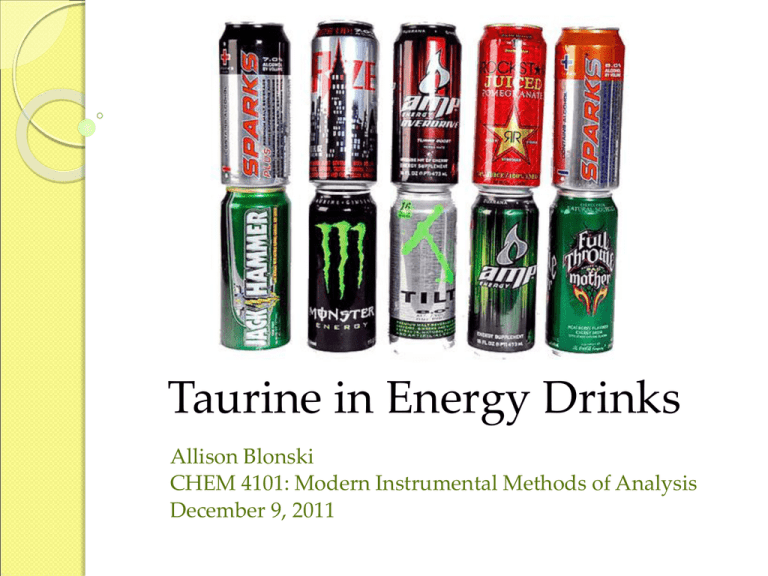
Taurine in Energy Drinks
Allison Blonski
CHEM 4101: Modern Instrumental Methods of Analysis
December 9, 2011
What is Taurine?
Sulfonic acid, often
considered a free
amino acid1
Obtained in diet
through meat
consumption
Important for
muscle functioning
Interacts with
caffeine, distressing
cardiac output
Exact Mass = 125.01466 Da2
Energy Drinks and Taurine
Taurine added to energy drinks to boost energy,
concentration, memory, and physical performance
Effective dosages of taurine range from 2,000 to
6,000 mg1
Potential health risks arise from interactions with
other compounds, including caffeine
Energy drinks containing both caffeine and taurine
have been connected to athlete deaths in Europe1
Central Problem
How much taurine is found in a serving of energy
drinks?
Does this amount of taurine provide any benefits?
Does this amount of taurine cause any health issues?
Hypothesis
The taurine content in a typical energy is below the
effective dosage required for any benefits, but high
enough to interact with caffeine, making taurinecontaining drinks more dangerous than those without
taurine.
Separation Techniques
Technique
Advantages
Disadvantages
Reverse Phase High
Performance Liquid
Chromatography
(HPLC)
Relatively low cost,
Somewhat slow
commonly used
procedure
technique, low sample
volume, good
separation
Capillary Isoelectric
Focusing (cIEF)
Sharp separation,
relatively fast, low
sample volume
Compound cannot be
derivatized, may be
difficult to fully
separate all
compounds in matrix
Capillary Zone
Electrophoresis (CZE)
Sharp separation,
relatively fast, low
sample volume
Difficult to combine
with optical detection
methods
Detection Methods
Technique
Advantages
Disadvantages
Fluorescence
Spectroscopy
Excellent S/N ratio,
high sensitivity
Compound requires
derivatization
Ultraviolet-Visible
Low cost, rapid
Absorption
procedure
Spectroscopy (UV-Vis)
Time of Flight Mass
Spectrometry (MSTOF) 2
Good resolution,
provides qualitative
confirmation
Relatively high limit
of detection (LOD)
and signal to noise
ratio (S/N), compound
requires derivatization
Expensive, weak
sensitivity, relatively
difficult to pair with
some separation
techniques
Procedure
Sample Preparation3
Derivitazation4
Measurement5
Deproteinate with
acetonitrile
Heat to 60° C
Inject 20 μL
Add 1 mL of sample
with 2 mL of 0.1 M
phosphate buffer
Excite sample at 473
nm
Centrifuge
Dilute to concentration
of 0.015 mg/mL
Add 1 mL 4-fluoro-7nitrobenzofurazan
(NBD-F) and stir 10
min
Measure emission at
550 nm
Reverse Phase HPLC Fluorescence
Separation based on polarity of compounds
Detection based on compound excitation and wavelength
emission
Compatible methods of separation and detection
Relatively low cost
Suitable selectivity and sensitivity for the matrix
6
Instrumentation
Bondclone μBondapak
C18 column WAT0273247
300 mm x 3.9 mm
Stationary phase = C18 chain
silica (10 μm diameter)
Mobile phase = 4:24:72 (THF:
acetonitrile: phosphate
buffer), pH = 9
1100 psi at 1 mL/min
Hitachi HTA HPLC
Detector - L-2485
Fluorescence9
8
S/N > 900
Excitation wavelength = 200
-850 nm
Emission wavelength = 250 –
900 nm
Band width = 15 nm
Accuracy within 3 nm
Limit of detection (LOD) =
0.015 ng/mL
Limit of quantification
(LOQ) = 0.0625 ng/mL
Possible Results
9
Calibration curve
would be created via
standard addition
Standard taurine can
be purchased
through Abblis
Scientific10
Addition of standard
taurine to energy
drinks without
taurine will serve as
a positive control
Conclusions
Reverse phase HPLC with detection
using fluorescence will provide a
suitable quantification of the taurine
found in energy drinks.
Further clinical research should be
done to examine the effects of taurine,
caffeine, and the combination of the
two on the human body.
References
1.
2.
3.
4.
5.
6.
7.
8.
9.
10.
Clauson, K.A.; Shields, K.M.; McQueen, C.E.; Persad, N. Safety issues associated with commercially
available energy drinks. J. Amer. Pharm. Assoc.[Online] 2008, 48, e55-e67.
http://www.pharmacytoday.org/ pdf/2008/May_CE_exam.pdf (accessed Sept 20, 2011).
Chen, Z.; Chen, B.; Yao, S. High-performance liquid chromatography/electrospray ionization-mass
spectrometry for simultaneous determination of taurine and
10 water-soluble vitamins in multivitamin tablets. A. Chem. Acta.[Online] 2006, 569, 169-175.
http://hgxy.hunnu.edu.cn/UploadFile/20061116102343585.pdf (accessed Oct 26, 2011).
McMahon, G.P.; O'Kennedy, R.; Kelly, M.T. High-performance liquid chromatographic determination
of taurine in human plasma using pre-column extraction and derivatization. J. Pharm. Biomed.
Anal.[Online] 1996, 14, 1287-1294. http://www.sciencedirect.com.ezp1.lib.umn.edu/science?
_ob=MiamiImageURL&_cid=271442&_user=616288&_pii=073170859501697X&_check=y&_origin=&_c
overDate=30-Jun-1996&view=c&wchp=dGLzVBA-zSkzk&md5=ada4407c4aeec0327c7acd073b2c28f8/1s2.0-073170859501697X-main.pdf(accessed Nov 3, 2011).
Sawabe, Y.; Tagami, T.; Yamasaki, K. Determination of Taurine in Energy Drinks by HPLC Using a
Pre-Column Derivative. J. Health Sci.[Online] 2008, 54, 661-664.
http://jhs.pharm.or.jp/data/54%286%29/54_661.pdf (accessed Sept 29, 2011).
Eidelman, O.; Zangvill, M.; Razin, M.; Ginsburg, H.; Cabantchik, Z.I. The anion-transfer system of
erythrocyte membranes. Biochem. J.[Online] 1981, 195, 503-513.
http://www.ncbi.nlm.nih.gov/pmc/articles/PMC1162915/pdf/biochemj00401-0160.pdf(accessed Oct 18,
2011).
http://www.comsol.com/shared/images/stories/waters_corp_hplc_systems/html/figure2.jpg (accessed
Dec 6, 2011)
Bondclone. http://www.brechbuehler.ch/fileadmin/redacteur/pdf/columns-sampleprep/lccolumns/zhbdc.pdf (accessed Nov 10, 2011).
http://images-mediawiki-sites.thefullwiki.org/09/2/3/8/3464321300074060.jpg (accessed Dec 6, 2011).
HPLC Detector – L-2485 Fluorescence - Hitachi HTA. http://www.hitachi-hta.com/products/lifesciences-chemical-analysis/liquid-chromatography/hplc-detector-l-2485-fluorescence (accessed Dec 6,
2011).
CAS Number: 107-35-7: 2-Aminoethanesulfonic acid.
http://www.abblis.com/product_AB1002120.html?&referrer=chemexper (accessed Oct 25, 2011).



